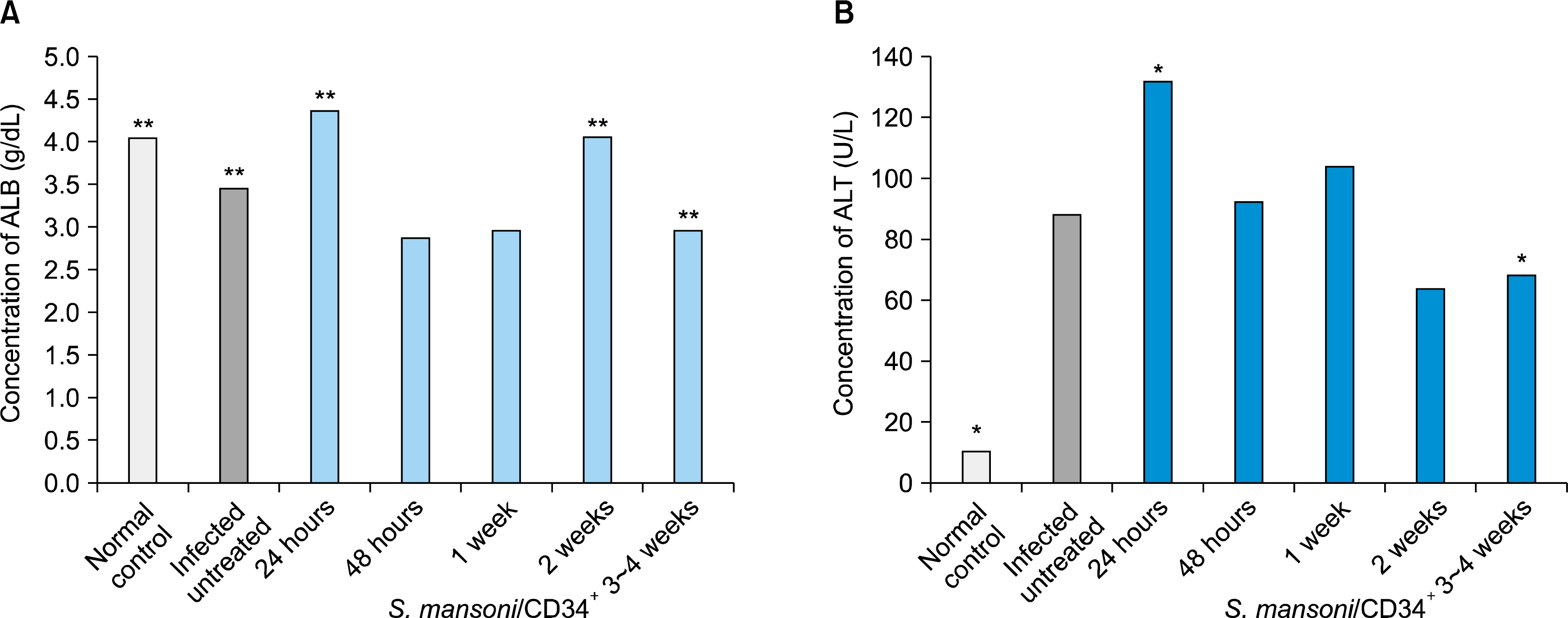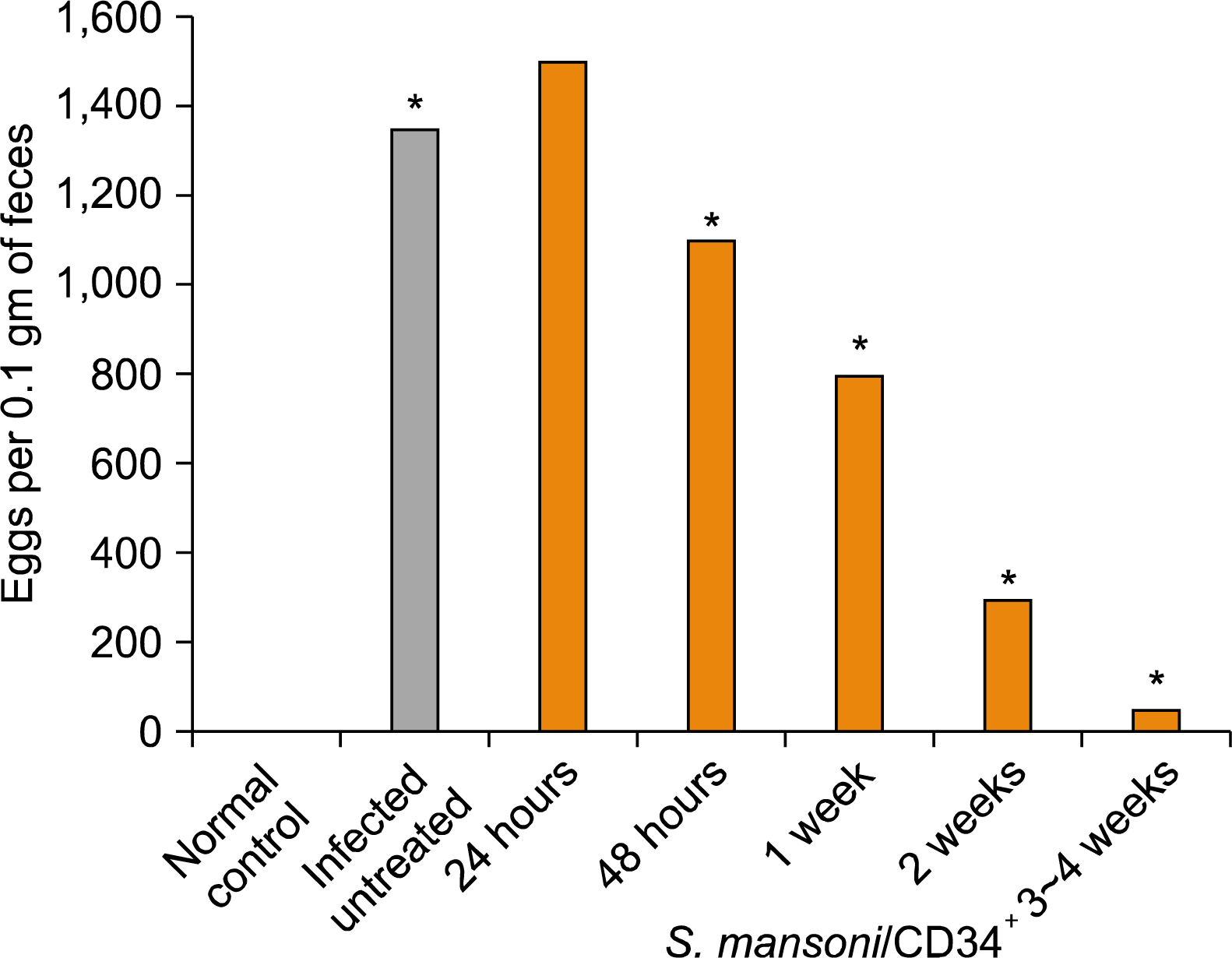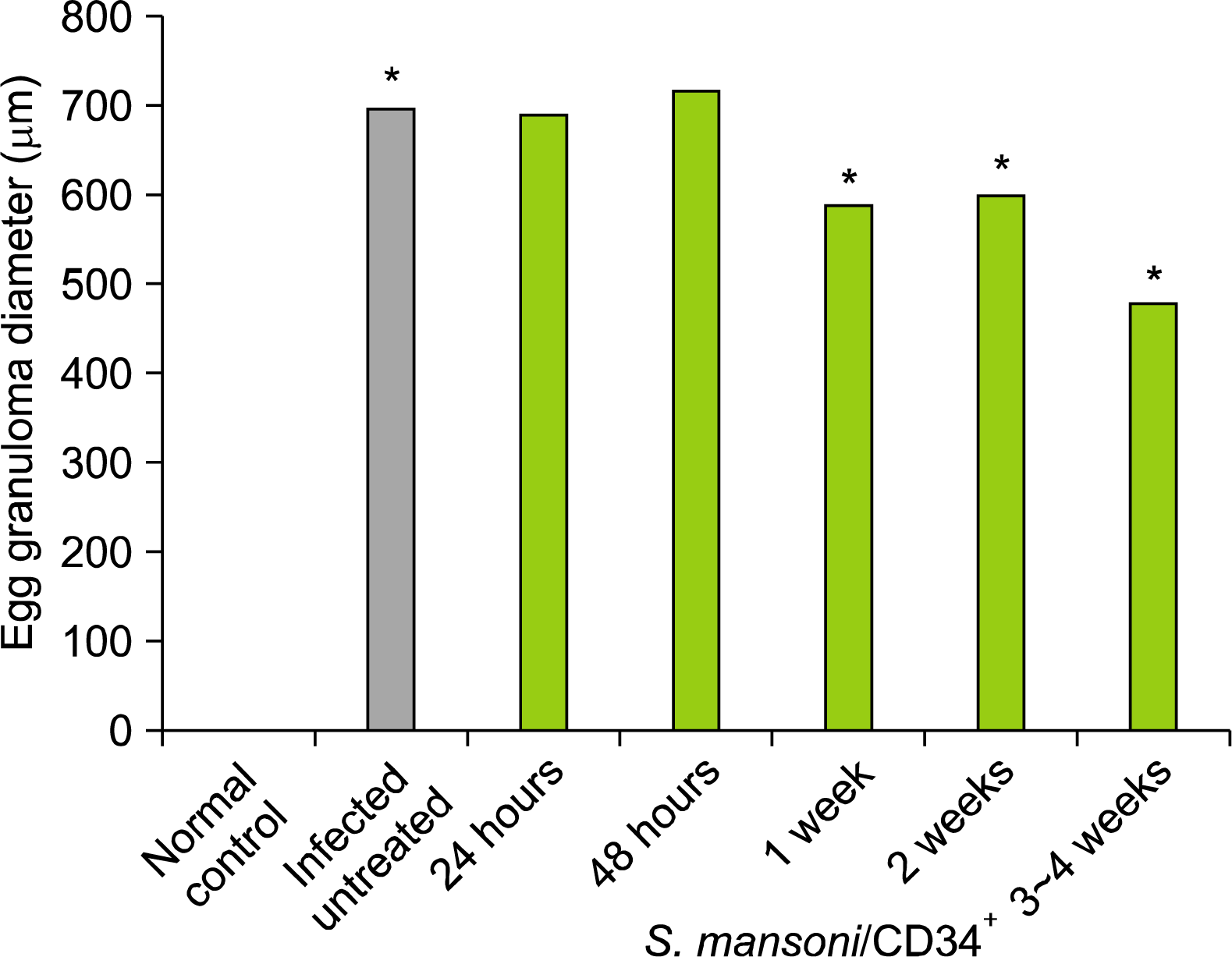1. Hasein MA, Attia FM, Awad MM, Abdelaal HA, Elbarabary M. Effect of human umbilical cord blood CD34
+ progenitor cells transplantation in diabetic mice. Int J Diabetes Dev Ctries. 2011. 31:113–117.

2. Yan Y, Xu W, Qian H, Si Y, Zhu W, Cao H, Zhou H, Mao F. Mesenchymal stem cells from human umbilical cords ameliorate mouse hepatic injury
in vivo. Liver Int. 2009. 29:356–365.

3. Abdel Aziz MT, Atta HM, Roshdy NK, Rashed LA, Sabry D, Hassouna AA, Aboul Fotouh GI, Hasan NM, Younis RH, Chowdhury JR. Amelioration of Murine Schistosoma mansoni Induced Liver Fibrosis by Mesenchymal Stem Cells. J Stem Cells Regen Med. 2012. 8:28–34.

4. Broxmeyer HE, Cooper S, Yoder M, Hangoc G. Human umbilical cord blood as a source of transplantable hematopoietic stem and progenitor cells. Curr Top Microbiol Immunol. 1992. 177:195–204.

5. Rocha V, Gluckman E; Eurocord and European Blood and Marrow Transplant Group. Clinical use of umbilical cord blood hematopoietic stem cells. Biol Blood Marrow Transplant. 2006. 12(1 Suppl 1):34–41.

6. Wagner JE, Gluckman E. Umbilical cord blood transplantation: the first 20 years. Semin Hematol. 2010. 47:3–12.

7. Tsuji M, Taguchi A, Ohshima M, Kasahara Y, Sato Y, Tsuda H, Otani K, Yamahara K, Ihara M, Harada-Shiba M, Ikeda T, Matsuyama T. Effects of intravenous administration of umbilical cord blood CD34
+ cells in a mouse model of neonatal stroke. Neuroscience. 2014. 263:148–158.

8. Broxmeyer HE, Douglas GW, Hangoc G, Cooper S, Bard J, English D, Arny M, Thomas L, Boyse EA. Human umbilical cord blood as a potential source of transplantable hematopoietic stem/progenitor cells. Proc Natl Acad Sci U S A. 1989. 86:3828–3832.

9. Roobrouck VD, Ulloa-Montoya F, Verfaillie CM. Self-renewal and differentiation capacity of young and aged stem cells. Exp Cell Res. 2008. 314:1937–1944.

10. Fuchs E, Tumbar T, Guasch G. Socializing with the neighbors: stem cells and their niche. Cell. 2004. 116:769–778.
11. Chitsulo L, Engels D, Montresor A, Savioli L. The global status of schistosomiasis and its control. Acta Trop. 2000. 77:41–51.

12. Frank C, Mohamed MK, Strickland GT, Lavanchy D, Arthur RR, Magder LS, El Khoby T, Abdel-Wahab Y, Aly Ohn ES, Anwar W, Sallam I. The role of parenteral anti-schistosomal therapy in the spread of hepatitis C virus in Egypt. Lancet. 2000. 355:887–891.

13. Seif el-Din SH, El-Lakkany NM, Mohamed MA, Hamed MM, Sterner O, Botros SS. Potential effect of the medicinal plants
Calotropis procera,
Ficus elastica and
Zingiber officinale against
Schistosoma mansoni in mice. Pharm Biol. 2014. 52:144–150.

14. Nascimento-Carvalho CM, Moreno-Carvalho OA. Neuroschistosomiasis due to
Schistosoma mansoni: a review of pathogenesis, clinical syndromes and diagnostic approaches. Rev Inst Med Trop Sao Paulo. 2005. 47:179–184.

15. Xu H, Qian H, Zhu W, Zhang X, Yan Y, Mao F, Wang M, Xu H, Xu W. Mesenchymal stem cells relieve fibrosis of
Schistosoma japonicum-induced mouse liver injury. Exp Biol Med (Maywood). 2012. 237:585–592.

16. Whiteley J, Bielecki R, Li M, Chua S, Ward MR, Yamanaka N, Stewart DJ, Casper RF, Rogers IM. An expanded population of CD34
+ cells from frozen banked umbilical cord blood demonstrate tissue repair mechanisms of mesenchymal stromal cells and circulating angiogenic cells in an ischemic hind limb model. Stem Cell Rev. 2014. 10:338–350.

17. Warren KS. The immunopathogenesis of schistosomiasis: a multidisciplinary approach. Trans R Soc Trop Med Hyg. 1972. 66:417–434.

18. El-Garem AA. Schistosomiasis. Digestion. 1998. 59:589–605.

19. Cheever AW, Macedonia JG, Mosimann JE, Cheever EA. Kinetics of egg production and egg excretion by
Schistosoma mansoni and
S. japonicum in mice infected with a single pair of worms. Am J Trop Med Hyg. 1994. 50:281–295.

20. Bartley PB, Ramm GA, Jones MK, Ruddell RG, Li Y, McManus DP. A contributory role for activated hepatic stellate cells in the dynamics of
Schistosoma japonicum egg-induced fibrosis. Int J Parasitol. 2006. 36:993–1001.

21. Gui M, Kusel JR, Shi YE, Ruppel A.
Schistosoma japonicum and
S. mansoni: comparison of larval migration patterns in mice. J Helminthol. 1995. 69:19–25.

22. Astegiano M, Sapone N, Demarchi B, Rossetti S, Bonardi R, Rizzetto M. Laboratory evaluation of the patient with liver disease. Eur Rev Med Pharmacol Sci. 2004. 8:3–9.
23. Pratt DS, Kaplan MM. Evaluation of abnormal liver-enzyme results in asymptomatic patients. N Engl J Med. 2000. 342:1266–1271.

24. Hassan MM, Hwang LY, Hatten CJ, Swaim M, Li D, Abbruzzese JL, Beasley P, Patt YZ. Risk factors for hepatocellular carcinoma: synergism of alcohol with viral hepatitis and diabetes mellitus. Hepatology. 2002. 36:1206–1213.

25. Cheever AW, Hoffmann KF, Wynn TA. Immunopathology of schistosomiasis mansoni in mice and men. Immunol Today. 2000. 21:465–466.
26. Pearce EJ, MacDonald AS. The immunobiology of schistosomiasis. Nat Rev Immunol. 2002. 2:499–511.

27. Kamal S, Madwar M, Bianchi L, Tawil AE, Fawzy R, Peters T, Rasenack JW. Clinical, virological and histopathological features: long-term follow-up in patients with chronic hepatitis C co-infected with
S. mansoni. Liver. 2000. 20:281–289.

28. Yan L, Cai H, Chen Y, Tan W. Effect of hepatocyte-like cells induced by CD34+ cells in vitro on the repair of injured hepatic tissues of mice in vivo. Zhongguo Xiu Fu Chong Jian Wai Ke Za Zhi. 2009. 23:1235–1240.
29. Newsome PN, Johannessen I, Boyle S, Dalakas E, McAulay KA, Samuel K, Rae F, Forrester L, Turner ML, Hayes PC, Harrison DJ, Bickmore WA, Plevris JN. Human cord blood-derived cells can differentiate into hepatocytes in the mouse liver with no evidence of cellular fusion. Gastroenterology. 2003. 124:1891–1900.

30. Alvarez-Mercado AI, García-Mediavilla MV, Sánchez-Campos S, Abadía F, Sáez-Lara MJ, Cabello-Donayre M, Gil A, González-Gallego J, Fontana L. Deleterious effect of human umbilical cord blood mononuclear cell transplantation on thioacetamide-induced chronic liver damage in rats. Cell Transplant. 2009. 18:1069–1079.

31. Bassiouny AR, Zaky AZ, Abdulmalek SA, Kandeel KM, Ismail A, Moftah M. Modulation of AP-endonuclease1 levels associated with hepatic cirrhosis in rat model treated with human umbilical cord blood mononuclear stem cells. Int J Clin Exp Pathol. 2011. 4:692–707.






 PDF
PDF Citation
Citation Print
Print




 XML Download
XML Download